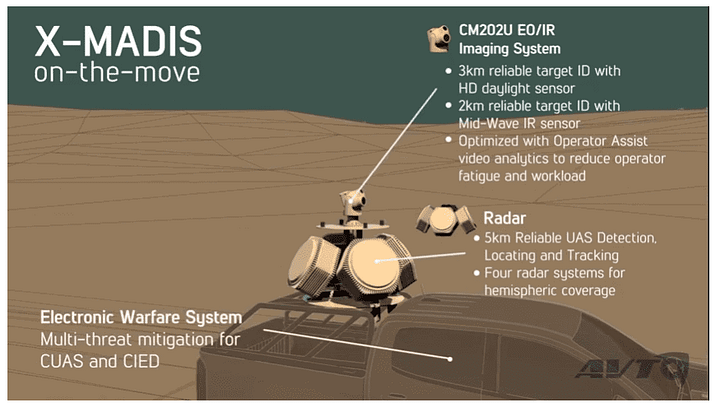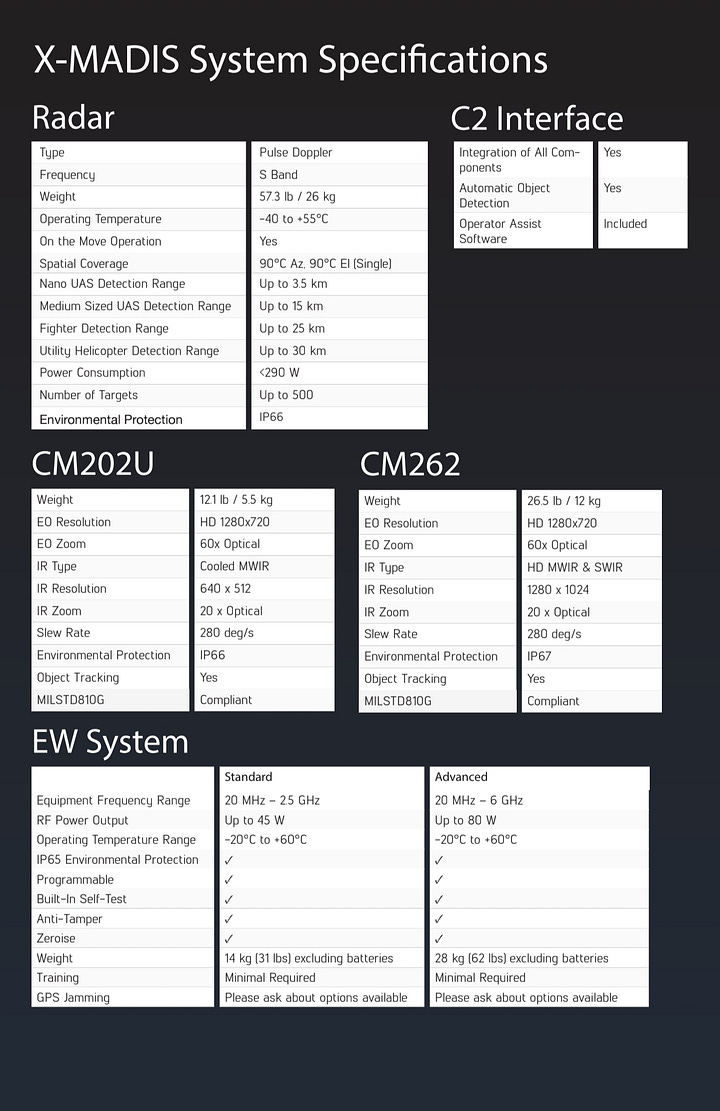CACI awarded new contract under Phase II of the Counter Unmanned Aerial System UOR.
The Government of Canada has finally announced a decision on the CUAS UOR Phase II initiative. CACI Inc. has been awarded two contracts totaling $169,187,671.90 for the procurement of vehicle-mounted CUAS systems.
This contract includes the integration and mounting of the CUAS onto a new light armoured tactical vehicle platform, as well as in-service support for the systems for up to 10 years.

The system being procured here, while not specified, is likely CACI’s X-MADIS system — more specifically, their On-The-Move variant, obviously. This is their second contract under the CUAS UOR, as the company was one of three awarded under Phase I of the project last year. That was for the Beam 3.0 backpack system.
According to CACI:
The X-MADIS is a battle-proven, rugged, and reliable solution that has been deployed in a range of extreme environments and conditions, providing unmatched counter-UAS protection on the move and in fixed locations. Capable of operating in urban, rural, and littoral environments.
The X-MADIS provides peace of mind for security and military personnel tasked with protecting VIPs and leaders; combat forces; military bases and assets; national borders; critical infrastructure; and public events.
Multi-mission functionality facilitates detection and early warning of traditional and improvised aerial threats; rockets and artillery fires; and IED threats, while providing long-range detection and surveillance of ground targets. The X-MADIS is a platform-agnostic, multi-mission solution that achieves reliable detection, identification, and defeat while moving at speeds exceeding 30 mph on rough terrain. The X-MADIS can be tailored to suit specific customers’ requirements.
The system is currently in service with the U.S. Air Force, U.S. Marine Corps, and several other unnamed operators I was unable to find information on. Several departments in the United States are known to have ordered the system.
It forms the upper echelon of CACI’s Skytracker Suite alongside the CORIAN fixed-site system and the SPaRK Passive Radar. While I doubt it was the deciding factor in the case of a UOR, the ability to acquire multiple, integrated solutions is always a benefit. Already having BEAM 3.0 in our inventory from Phase I, using a lot of the same technology and software, undoubtedly was a benefit in this choice.


As for X-MADIS itself? The system features CACI’s All-Threat Tactical Surveillance Radar, providing 360° hemispheric coverage out past 5 km. The system can be employed in CUAS, C-RAM, and Ground Surveillance roles.
It is joined by one of CACI’s Gyro-Stabilized, Multi-Sensor Optics for Positive Identification. It is designed to accept a number of in-house or third-party non-kinetic effectors for dealing with UAS up to Class III.
The system will be integrated onto a new Light Tactical Vehicle as part of this contract, alongside existing and future systems. We do not know what that will be, though if I had to guess it would be the Cambli Blackwolf, as it is already being brought in as part of the RBS70NG contract.
First deliveries start in Fall of next year, and FOC is scheduled for 2028. We have a bit of a delay here from what was originally planned. The contract was supposed to be awarded last year, but has seen several delays to the award process. I don’t know why exactly, but it was enough to make me honestly forget that it existed. This caught me by surprise.
It’s good to see, though — although the current process to acquire CUAS has been slow and not nearly as extensive as it needs to be, far from it. While it is nice to see some capability be funneled into where it’s needed most, we do need a proper plan to rapidly and extensively integrate new CUAS, both kinetic and non-kinetic, across CAF.
Unmanned systems are rapidly advancing, and so is the technology needed to challenge them. We can't afford for the process to be bogged down by years of procurement, nor allow it to suffer a similar bureaucratic mess that was GPUAS.
This is a UOR. It is, at the end of the day, a limited, supposedly quick solution. That is despite the fact that from its announcement to FOC in 2028, we will see a five-year period between full capability for what is supposed to be an ‘Urgent Requirement’. That is absolutely unacceptable of a timeline, especially when we're talking about a field that is constantly evolving on a month-to-month timespan.
More needs to be done, but this is a proper step. We need a proper framework for allowing units to rapidly acquire new CUAS systems. We need to push forward things like Enduring Phase II to provide a kinetic CUAS capability.
A lot needs to be done, but as always, we take wins where we get them.

